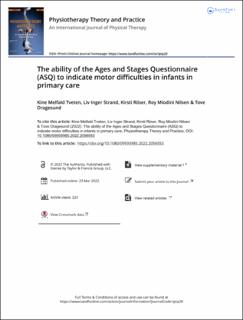| dc.contributor.author | Tveten, Kine Melfald | |
| dc.contributor.author | Strand, Liv Inger | |
| dc.contributor.author | Riiser, Kirsti | |
| dc.contributor.author | Nilsen, Roy Miodini | |
| dc.contributor.author | Dragesund, Tove | |
| dc.date.accessioned | 2022-08-05T11:09:59Z | |
| dc.date.available | 2022-08-05T11:09:59Z | |
| dc.date.created | 2022-04-25T13:54:01Z | |
| dc.date.issued | 2022 | |
| dc.identifier.issn | 0959-3985 | |
| dc.identifier.uri | https://hdl.handle.net/11250/3010355 | |
| dc.description.abstract | Introduction
Delayed achievement of motor milestones may be an early indicator of motor difficulties. Parent-reported questionnaires may serve as an efficient, low-cost screening to identify infants in need of further clinical assessment, and thus be a helpful tool in busy health care centers.
Purpose
To examine the ability of the Ages and Stages Questionnaire, second edition (ASQ-2) to indicate motor difficulties in infants using the Infant Motor Profile (IMP) as the reference standard.
Methods
A cross-sectional design was applied to examine the correlation between parent-reported data of the ASQ-2 and data from physiotherapist assessment using IMP. Included were 432 mainly low-risk infants aged 3–12 months from primary care.
Results
Overall, ASQ-2 gross and fine motor scores did not correlate well with the IMP total or domain scores. The ASQ-2 gross motor cut point (> 2SD below the mean), showed 34.3% sensitivity and 96.7% specificity using the 15th percentile from IMP performance domain as reference standard. The positive predictive value to indicate motor difficulties was 48%.
Conclusion
The motor domains of ASQ-2 have poor ability to identify infants with motor difficulties as indicated by their IMP scores in low-risk infants. | en_US |
| dc.language.iso | eng | en_US |
| dc.rights | Attribution-NonCommercial-NoDerivatives 4.0 Internasjonal | * |
| dc.rights.uri | http://creativecommons.org/licenses/by-nc-nd/4.0/deed.no | * |
| dc.title | The ability of the Ages and Stages Questionnaire (ASQ) to indicate motor difficulties in infants in primary care | en_US |
| dc.type | Journal article | en_US |
| dc.type | Peer reviewed | en_US |
| dc.description.version | publishedVersion | en_US |
| dc.rights.holder | Copyright 2022 The Author(s) | en_US |
| cristin.ispublished | true | |
| cristin.fulltext | original | |
| cristin.qualitycode | 1 | |
| dc.identifier.doi | 10.1080/09593985.2022.2056553 | |
| dc.identifier.cristin | 2018933 | |
| dc.source.journal | Physiotherapy Theory and Practice | en_US |
| dc.identifier.citation | Physiotherapy Theory and Practice. 2022. | en_US |

